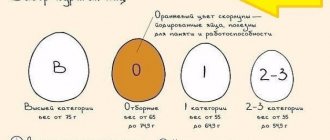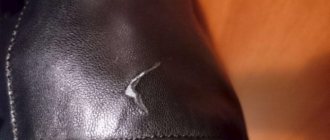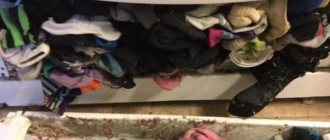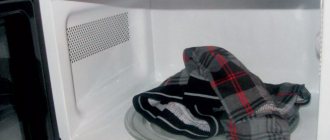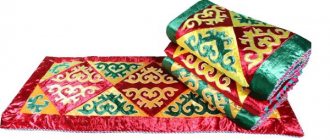Among the fasteners for clothing there are buttons that are not sewn on, but are installed in a specific place using a special device. Like a sew-on button, such a button consists of two parts; in one of the parts (the top one, which is visible from the front side of the garment) there is a hole, and in the other (bottom) there is a cylindrical protrusion corresponding to the diameter of the hole. When the cylinder enters the hole, the button parts close together and connect the garment parts on which they are installed to each other. Unlike a sew-on button, each part of the button shown in the photo consists of two more parts, which are installed on both sides of the fabric and tightly fixed into each other.
If you have a need to shorten the sleeve of a purchased shirt, and there is nothing else left to do but tear off the cuffs, trims and facings, cut off the excess length from the bottom of the sleeve, decorate the cut at the bottom of the sleeve with the same facings and trims (since the shirt was not sewn by you, and a suitable there is no new fabric for the pattern), sew cuffs to the new line of the bottom of the sleeves, you may encounter the following situation. One of the parts of the button fastener may be located very close to the edge of the facing or even partially extend onto the fabric of the sleeve part; in this case, it will not be possible to sew the facing to a new place without dismantling the button, since it will prevent the sleeve fabric from entering between the layers facings.
Let's try to carefully dismantle (remove from the fabric) the lower part of the fastener button and install it in a new place.
We will need: a thin flat-head screwdriver and pliers.
Removing the fastener part
Carefully insert the end of the screwdriver between the fabric and the base of the fastener button, checking if there are spikes that attach the base to the fabric. They are there, but they are short, so we slightly bend the base disk to remove the spikes, but not damage the fabric or break the button. This way we check the details of the button on both sides of the fabric.
Now we place the screwdriver between the base of the fastener button and the fabric from the inside, as deep as possible, carefully scroll and separate the parts of the button from each other. A hole remains in the facing the size of the button cylinder.
Installing the snap button part
We stitch the facing to the corresponding side of the new cut. We make a hole in the sleeve fabric between the facing layers.
From the reverse side, insert the lower part of the button-fastener into the hole, the fabric of the hole should tightly surround the cylinder of the button, cut off the fringe, and press the fabric tightly to the base of the button. From the front side we put the upper one on the lower part of the button. Using pliers, lightly squeeze them (be careful not to damage the shape of the protrusion) until you hear a click (there should be a click, it indicates that the parts of the button fastener fit tightly into each other and will not separate without impact).
This is how you can carefully move the bottom part of the button yourself without using special equipment.
Share on social media networks:
Accessories for clothing are an additional decoration and accessory. However, even expensive branded clothing is often equipped with low-quality fittings. This applies to both buttons and clips, hooks and zippers. In order not to seek help from a studio, you need to learn how to work with various sewing accessories yourself. Installing buttons on clothes at home will not take much time; this can be done using a simple set of tools. Today we will tell you how to put a rivet on clothes at home, using available materials and tools, thereby saving money by not buying a special press for installing buttons.
How to repair a slightly torn knit button?
A variety of attachments, which the design of the punch suggests, allows you to make holes of different diameters.
If the hole has uneven edges or is burned, then it will not be possible to tighten the edges; you will have to install an external patch. They disguise it with a decorative seam or some kind of label. You can repair the down jacket yourself if a hole accidentally appears there (a small cut or hot ash from a cigarette) yourself.
Although a down jacket is a very comfortable, warm and inexpensive winter outerwear, the fabric is not durable, so it can easily be torn if it gets caught on something. On hiking trips, a down jacket can be burned by a spark from a fire or torn on thorny branches of bushes.
This happens due to microparticles of powder located deep inside the clothing. They will continue to appear until you wash, and most importantly, rinse the down jacket several times.
Now I’m at work, while I still have time to think about what to do... Were you able to shoot a rivet in a regular metal repair shop? And one more question: was your riveting “original” or was it picked up in a workshop?
Go to the “Charm” atelier, Karl Marx St., 7-a, there are absolutely any buttons, rivets, eyelets and fittings, and all sorts of other things. And even buttons and buttons are covered with whatever you want. They do everything quickly and beautifully and as it should .The best studio! Their phone number is 89027852402.
Now I’m at work, while I still have time to think about what to do... Were you able to shoot a rivet in a regular metal repair shop? And one more question: was your riveting “original” or was it picked up in a workshop?
When installing any accessories by hand using these tools, the main thing is not to overdo it with the force of the impact with milk))) the impact should be medium, on a hard surface (I always install it on the floor, and at the same time I put a cutting board 20mm thick).
Full version. Can I return a down jacket if the down is coming out and the rivet is broken? Help please. Show comments. Dary14 November 30 Copy link to message. I bought a down jacket for RUR. I came home, took it off and saw that a little fluff had come out on the seams and there was a little left on the inside of the jacket. Well, I think maybe he’ll get used to it and won’t climb anymore.
In addition, it would be wiser to buy fur products in the same city where you live. It is not uncommon for a buyer, having purchased a fur coat far from home, to discover defects too late, but is no longer able to return it. Sellers of inexpensive fur coats who sell them to tourists are counting on this. My daughter has a Belarusian-made Bologna jacket, which is basically of high quality, but with each wash the rivets on the jacket become more and more rusty. Apparently the Belarusians saved on the quality of metal for rivets :). Anyone have any ideas or experience, please share?
Dear readers! Our articles talk about typical ways to resolve legal issues, but each case is unique.
The trial is still a long time. Our trial with the repairmen lasted 5 months, including cassation. I am not dissuading this
